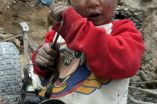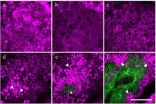(Press-News.org) A hearing system component thought to be unique in toothed whales like dolphins has been discovered in insects, following research involving the University of Strathclyde.
The research is challenging ideas about how a large group of insects including crickets and katydids hear, revealing the unexpected similarity to toothed whale hearing.
Scientists from the School of Biological Sciences at The University of Auckland, with colleagues from Plant & Food Research in New Zealand, led the research with engineers from the University of Strathclyde working on the biomechanical aspects of the project.
They discovered that the iconic New Zealand insect, the weta, rely on a unique lipid – a compound that includes oils and fats – to hear the world around them.
Dr James Windmill, of the University of Strathclyde's Centre for Ultrasonic Engineering, said: "As engineers we are particularly interested in how sound interacts with certain materials and how it travels to and from a source. These findings help us to improve our fundamental knowledge and could inspire new systems in ultrasound technologies like biomedical and non-destructive testing.
"The discovery is interesting as previously only toothed whales were known to use this hearing system component, the lipid. There are many similarities in the use of lipids to amplify the sounds and help both animal groups to hear.
"We don't know why animals who are so far apart in evolutionary terms have this similarity, but it opens up the possibility that others may use the same system component."
The sound is known to be transmitted through a liquid-filled cavity to reach the hearing organs, but until the current research was carried out it was presumed that the liquid was simply the insect equivalent of blood.
The researchers found that it was in fact a lipid of a new chemical class. They believe the role of the lipid is to efficiently transmit sound between compartments of the ear, and perhaps to help amplify quiet sounds.
Dr Kate Lomas from the University of Auckland, said: "In the weta, as in other members of the Ensiferan group which includes katydids and crickets, sound is detected by ear drums on the front legs."
Using new tissue analysis and three-dimensional imaging techniques the scientists also discovered a tiny organ in the insects' ears, which they named the olivarius after Dr Lomas' son Ollie. The organ appears to be responsible for producing the all-important lipid.
It may have been overlooked in previous studies because standard analytical techniques, which are much harsher, would have damaged or destroyed the fragile tissue.
Dr Lomas added: "The ear is surprisingly delicate so we had to modify how we looked at its structure and in doing so we discovered this tiny organ."
The researchers carried out their work with the Auckland tree weta. They believe that the same method of hearing is likely to be used by other members of its biologic class, including crickets and katydids, which are famous for the sounds they produce.
###
The researched has been published in the PLOS journal – available online at: http://dx.plos.org/10.1371/journal.pone.0051486
END
An anesthetic regimen typically used during surgery on pregnant mothers appears to have a negative effect on the development of the fetus, according to a new study on mice conducted by neurobiologists from the National Center for Toxicological Research, in Arizona.
In the article 'Inhalation Anesthesia-Induced Neuronal Damage and Gene Expression Changes in Developing Rat Brain' published earlier this month in Systems Pharmacology, an open access journal by Versita – Dr. Fang Liu and Dr. Cheng Wang describe the effect of major, commonly used anesthetic compounds – Nitrous ...
Scientists have developed a new method for studying parasite numbers in the stomachs of individual seabirds in the wild. The technique enables the recording of video footage of worms inside seabird stomachs and is an important step forward in understanding the impact of parasites on seabird populations. The research is published today (13 December 2012) in the scientific journal Methods in Ecology and Evolution.
The research team trialled the use of endoscopy, often used in human and veterinary medicine but rarely in field situations, to measure natural parasite loads, ...
Labour conditions, the amount of hours and working during the morning are the factors that most negatively affect the academic development of children who work. Using data from the 'Edúcame primero Colombia' Project ('Educate me first Colombia' in Spanish), a group of researchers in which the University of Seville participates has confirmed the incompatibility between studying and child labour.
The International Labour Organisation states that, in 2010, approximately 215 million children across the world were working. This figure has been progressively decreasing in ...
More than two hundred gene locations have now been identified for the chronic bowel condition Crohn's Disease, in a study that analysed the entire human genome.
Published today in The American Journal of Human Genetics, scientists at UCL have devised a new method for identifying and mapping gene locations for complex inherited diseases. Using this method, they have been able to identify a large number of additional genes for Crohn's Disease, making a total of more than 200, which is more than have been found for any other disease. For example, there are just 66 known ...
Philadelphia, Pa. (December 13, 2012) – Analysis of media portrayals of nursing homes finds that negative stories outnumber positive stories by five to one, reports a study in the December issue of Medical Care. The journal is published by Lippincott Williams & Wilkins, a part ofWolters Kluwer Health.
Negative news coverage of nursing homes may shape public perceptions and consumer care choices, suggest Edward Alan Miller, PhD, MPA, of University of Massachusetts Boston and Denise A. Tyler, PhD, of Brown University. They write, "Our findings suggest that negative reporting ...
Randomly distributed sticky spots which are integral to the development of stem cells by maximising adhesion and acting as internal scaffolding have been artificially recreated by experts from the University of Sheffield for the first time.
Using synthetic foam type materials to mimic the natural process – known as the extracellular matrix or ECM – scientists, from the University of Sheffield and University of California San Diego, created the random stickiness required for stem cells to properly adhere.
The findings will better inform researchers across the world of ...
WASHINGTON, DC, December 13, 2012 — Three University of Kentucky (UK) sociologists have co-authored a study that helps to fill a gap in our understanding of suicide risk among African-American women.
Appearing in the December issue of Social Psychology Quarterly (SPQ), the study, "Too Much of a Good Thing? Psychosocial Resources, Gendered Racism, and Suicidal Ideation among Low Socioeconomic Status African American Women," examines the relationship between racial and gender discrimination and suicidal ideation, or thinking about and desiring to commit suicide. The co-authors ...
PITTSBURGH—What is everyone looking at? It's a common question in social settings because the answer identifies something of interest, or helps delineate social groupings. Those insights someday will be essential for robots designed to interact with humans, so researchers at Carnegie Mellon University's Robotics Institute have developed a method for detecting where people's gazes intersect.
The researchers tested the method using groups of people with head-mounted video cameras. By noting where their gazes converged in three-dimensional space, the researchers could determine ...
Their review is published online in the Springer publication, Psychonomic Bulletin and Review.
A certain amount of mental deterioration is expected with advancing age. However, this may not necessarily have to be the case as particular aspects of cognitive function such as task switching, selective attention and working memory among others, all appear to benefit from aerobic exercise. Studies in older adults reviewed by the authors consistently found that fitter individuals scored better in mental tests than their unfit peers. In addition, intervention studies found scores ...
Wrinkles, dryness, and a translucent and fragile appearance are hallmarks of old skin, caused by the natural aging of skin cells. But while most of us can recognize the signs of lost youth when we peer into the mirror each morning, scientists do not have a standardized way to measure the extent of age damage in skin. Now a group of Taiwanese researchers has used a specialized microscope to peer harmlessly beneath the skin surface to measure natural age-related changes in the sizes of skin cells. The results, which are published in the Optical Society's (OSA) open-access ...


